Explore the intricacies of employment trends with our Comprehensive and Simple notes on Class 12 Economics (IED) Chapter 6 Employment: Growth, Informalization, and Other Issues. Delve into the dynamic world of job growth, informatization, and other critical issues in the realm of economics education. Gain valuable insights into the challenges and opportunities that await in the ever-evolving job market.
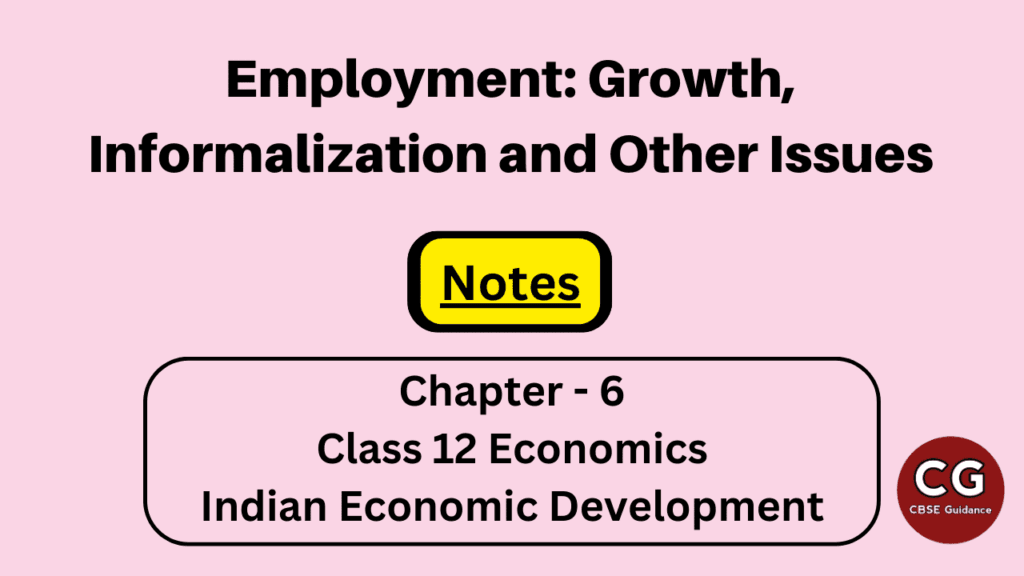
| Board | CBSE and State Boards |
| Class | 12 |
| Subject | Economics |
| Book Name | Indian Economic Development (IED) |
| Chapter No. | 6 |
| Chapter Name | Employment: Growth, Informalization, and Other Issues |
| Type | Notes |
| Session | 2024-25 |
"Education is not only a ladder of opportunity, but it is also an investment in our future."
-Ed Markey
Employment: Growth, Informalization, and Other Issues Class 12 Notes
Table of Contents
Workers and Employment
Economic Activities: Those activities which contribute to the gross national product are called economic activities.
Workers: All those who are engaged in economic activities, in whatever capacity — high or low, are workers.
- Even if some of them temporarily abstain from work due to illness, injury, or other physical disability, bad weather, festivals, or social or religious functions, they are also workers.
- Workers also include all those who help the main workers in these activities, even if they are not paid for it.
- Those who are self-employed are also workers.
The nature of employment in India is multifaceted:
- Some get employment throughout the year;
- Some others get employed for only a few months in a year.
- Many workers do not get fair wages for their work.
During 2017-18, India had about a 471 million strong workforce.
Participation of People in Employment
Worker-Population Ratio: The worker-population ratio is an indicator that is used for analyzing the employment situation in the country. This ratio is useful in knowing the proportion of the population that is actively contributing to the production of goods and services of a country.
Worker-Population Ratio = Total No. of Workers/Total Population x 100
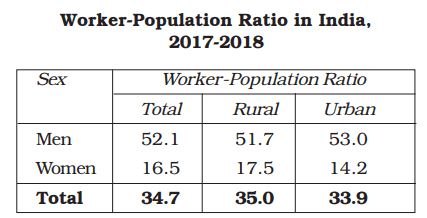
The worker-population ratio of India is about 35.
In urban areas, the ratio is about 34, whereas in rural India, the ratio is about 35. It means more people in rural areas work compared to urban areas because:
- People in rural areas have limited resources to earn a higher income and participate more in the employment market.
- Many do not go to schools, colleges, and other training institutions. They discontinue in the middle to join the workforce
- Whereas, in urban areas, a considerable section is able to study in various educational institutions.
- Urban people have a variety of employment opportunities.
- They look for the appropriate job to suit their qualifications and skills.
- In rural areas, people cannot stay at home as their economic condition may not allow them to do so.
Compared to urban women, more rural women are found working because:
- It is common to find that where men are able to earn high incomes, families discourage female members from taking up jobs.
- many household activities done by women are not recognised as productive work. This narrow definition of work leads to the non-recognition of women’s work and, therefore, to the underestimation of the number of women workers in the country.
Self-Employed and Hired Workers
Classification of workers on the basis of status: (helps in knowing the quality of employment in a country)
- Self-employed: Workers who own and operate an enterprise to earn their livelihood are known as self-employed. About 52% workforce in India belongs to this category.
- Casual Wage Laborers: Such laborers are casually engaged in others’ farms and, in return, get remuneration for the work done. They account for about 25% of India’s workforce.
- Regular Salaried Employees: When a worker is engaged by someone or an enterprise and paid his or her wages on a regular basis, they are known as regular salaried employees. They comprise 23% of the workforce.
Thus, self-employment is a major source of livelihood for both men and women as this category accounts for more than 50% of the workforce. Casual wage work is the second major source for both men and women.
Self-employment is the major source of employment in rural India: In rural areas, non-farm job opportunities are limited. People generally do not show a preference for acquiring skills and training for non-farm occupations. They prefer to stay on family farms and fields as self-employed.
Regular salaried employees are more in urban areas than in rural areas:
- Everyone cannot run factories, shops, and offices of various types.
- Moreover, enterprises in urban areas require workers on a regular basis.
Employment in Firms, Factories, and Offices
Generally, we divide all economic activities into eight different industrial divisions. They are
- (i) Agriculture
- (ii) Mining and Quarrying
- (iii) Manufacturing
- (iv) Electricity, Gas and Water Supply
- (v) Construction
- (vi) Trade
- (vii) Transport and Storage and
- (viii) Services.
(a) primary sector which includes (i) and (ii),
(b) secondary sector which includes (iii), (iv), and (v) and
(c) service sector which includes divisions (vi), (vii), and (viii).
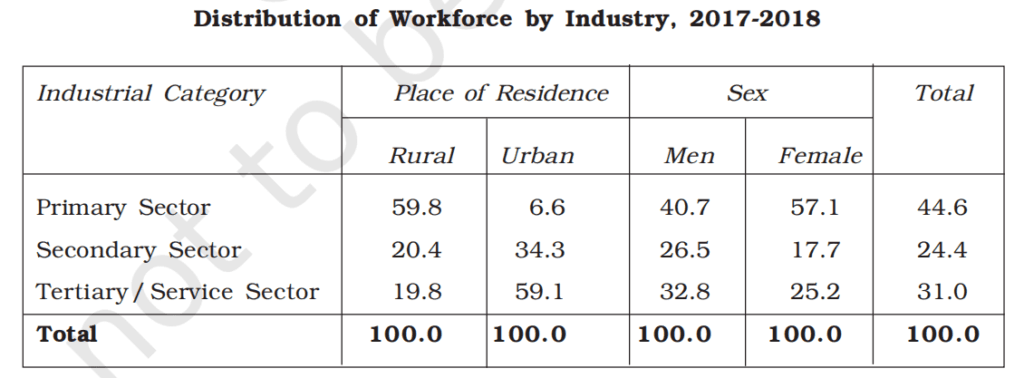
- The primary sector is the main source of employment for a majority of workers in India.
- The secondary sector provides employment to only about 24% of the workforce.
- About 31% of workers are in the service sector.
- The above table also shows that about 60% of the workforce in rural India depends on the primary sector.
- About 20% of rural workers are working in the secondary sector.
- The service sector provides employment to about 20% of rural workers.
- Newly emerging jobs are found mostly in the service sector.
- About 60% of urban workers are in the service sector.
- Women workers’ concentration is very high in the primary sector.
Growth and Changing Structure of Employment
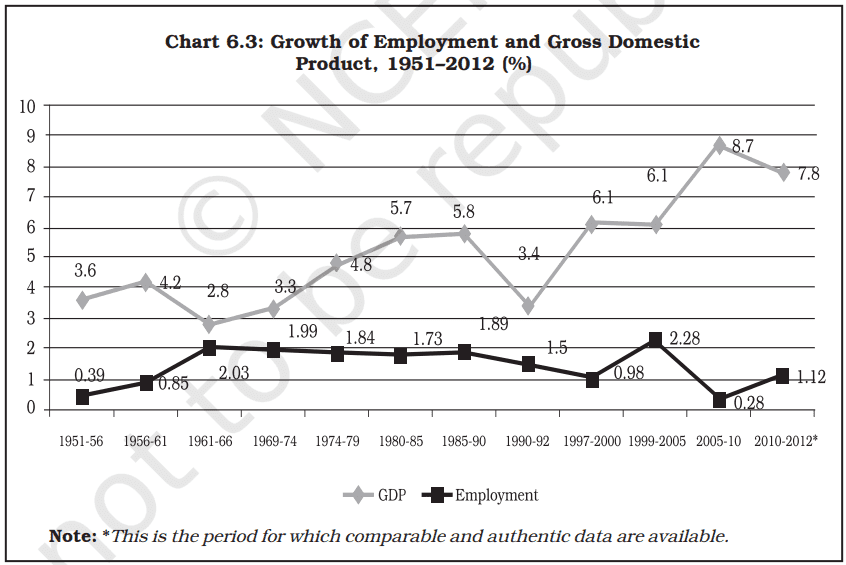
- During the period 1950–2010, the Gross Domestic Product (GDP) of India grew positively and was higher than the employment growth. However, there was always fluctuation in the growth of GDP.
- During this period, employment grew at a rate of not more than 2 %.
- In the late 1990s, employment growth started declining and reached the level of growth that India had in the early stages of planning.
- During these years, we also find a widening gap between the growth of GDP and employment. This means that in the Indian economy, without generating employment, we have been able to produce more goods and services. This phenomenon is called jobless growth.
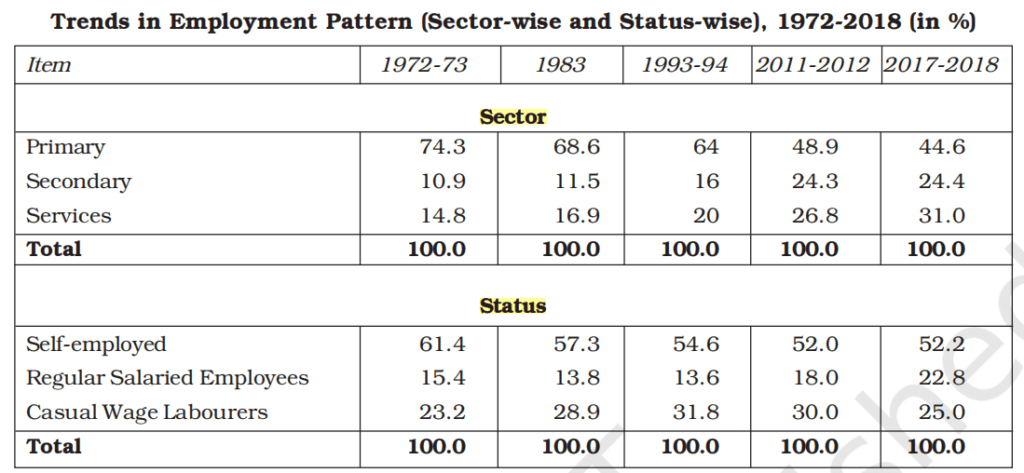
Distribution of the workforce by industrial sectors shows a substantial shift from farm work to non-farm work.
- In 1972-73, about 74% of the workforce was engaged in the primary sector, and in 2017-18, this proportion declined to about 45%.
- The shares of the Secondary and Services sectors have increased from 11 to 24% and 15 to 31%, respectively.
The distribution of the workforce in different statuses indicates that over the last five decades (1972-2018), people have moved from self-employment and regular salaried employment to casual wage work. Yet self-employment continues to be the major employment provider.
Scholars call the process of moving from self-employment and regular salaried employment to casual wage work noticed during 1972-94 as the casualization of the workforce.
Informalization of the Indian Workforce
Formal/Organized Sector: All the public sector establishments and those private sector establishments which employ 10 hired workers or more are called formal sector establishments and those who work in such establishments are formal sector workers.
Informal/Unorganized Sector: All other enterprises and workers working in those enterprises form the informal sector.
Thus, the informal sector includes millions of farmers, agricultural laborers, owners of small enterprises, and people working in those enterprises as well as the self-employed who do not have any hired workers. It also includes all non-farm casual wage laborers who work for more than one employer such as construction workers and headload workers.
The percentage of people employed in the formal sectors in the country is only 6%.
The rest 94% are in the informal sector.
In recent years, India has witnessed an unprecedented shift in the workforce from the formal sector to the informal sector. This process whereby, the proportion of informal workers in the total workforce increases is known as informalisation of the workforce.
Unemployment
Unemployment: It is a situation in which all those who, owing to lack of work, are not working but either seek work through employment exchanges, intermediaries, friends, or relatives or by making applications to prospective employers or expressing their willingness or availability for work under the prevailing condition of work and remunerations.
Types of unemployment:
i. Disguised unemployment refers to a situation in which a portion of the workforce is employed in jobs that do not fully utilize their skills, abilities, or labor potential. In disguised unemployment, people are officially employed, but their contribution to the production process is minimal or redundant. Suppose a farmer has four acres of land and he actually needs only two workers and himself to carry out various operations on his farm in a year, but if he employs five workers and his family members such as his wife and children, this situation is known as disguised unemployment.
ii. Seasonal unemployment is a type of unemployment that occurs when there is a temporary decrease in demand for labor during certain times of the year. Work in agriculture is seasonal; there are no employment opportunities in the village for all months of the year. When there is no work to do on farms, people go to urban areas and look for jobs.
iii. Open unemployment, also known as visible unemployment or overt unemployment, refers to a situation in which individuals who are actively seeking employment are unable to find suitable jobs despite their willingness and readiness to work.
Government and Employment Generation
Mahatma Gandhi National Rural Employment Guarantee Act 2005: It promises 100 days of guaranteed wage employment to all rural households who volunteer to do unskilled manual work.
Since Independence, the Union and State governments have played an important role in generating employment or creating opportunities for employment generation:
- Various government departments/enterprises employ people and increase their output of goods and services, leading to direct employment.
- When the output of goods and services from government enterprises increases, then private enterprises that receive raw materials from government enterprises will also raise their output. Subsequently, private enterprises using these outputs are indirectly benefitted from the increase in the scale of production. This leads to an increase in the number of employment opportunities indirectly in the economy.
- Many programmes that the governments implement, aimed at alleviating poverty, are through employment generation. They are also known as employment generation programmes.
| Also Read: Class 12 Important Questions Class 12 Notes |
Hope you liked these Notes on Class 12 Economics Indian Economic Development Chapter 6 Employment: Growth, Informalization, and Other Issues. Please share this with your friends and do comment if you have any doubts/suggestions to share.
THIS WEBSITE IS VERY USEFUL ,AND HELPFUL, PROVIDES WITH PROPER NOTES WHICH IS EASY TO LEARN AND REMEMBER…………….